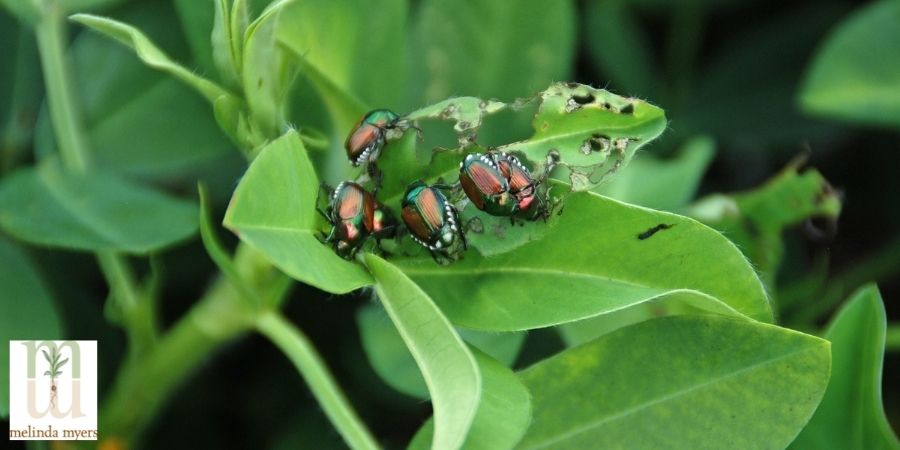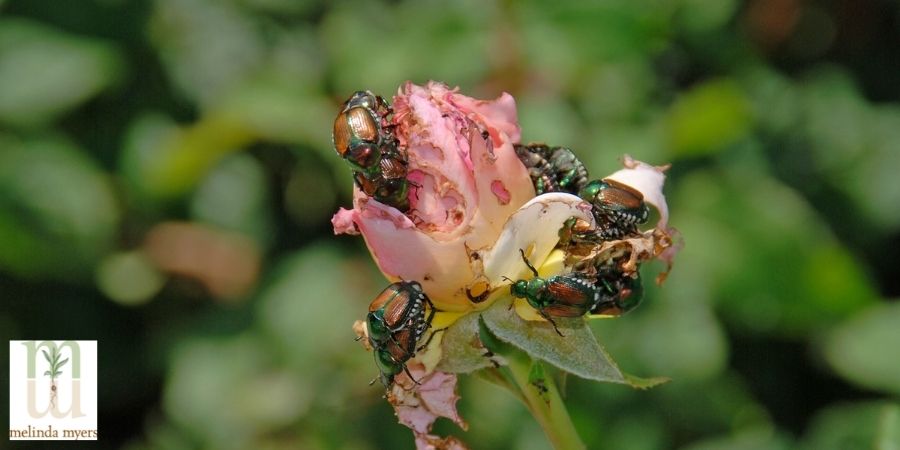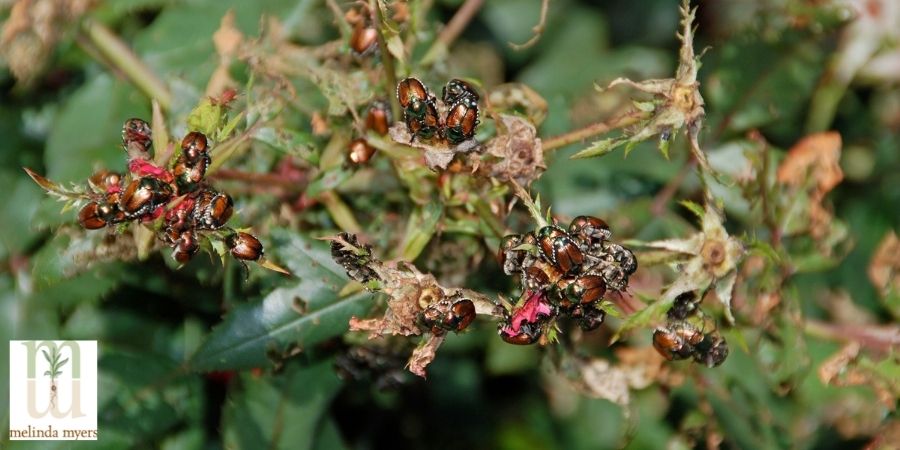Controlling Japanese Beetles in the Lawn and Garden
- horticulturist and gardening expertJune 5, 2021
You can’t miss them. These voracious beetles eat and mate in broad daylight feeding on the leaves and flowers of 350 different types of plants. Norway and Japanese maples, birch, crabapples, purple-leaf plum, rose, mountain ash, linden, grapes, and basil are among their favorites. But if you are battling these insects, you have a list of your own like hibiscus, cannas, and many more. Those are just a few that are on my list as well. When immature, the grubs feed on the roots of lawn grass, vegetables, and ornamental plants.
Japanese beetles first arrived in the United States in 1916 and are currently found in most states. Some western states have quarantine restrictions in place to help restrict the spread of this pest.
Japanese Beetle Damage
Japanese beetle adults eat the leaf tissue between the veins resulting in a lacey appearance. Some gardeners living with this pest refer to the riddled leaves on otherwise healthy plants as Japanese lace. Large populations can cause more severe damage resulting in brown and falling leaves.

The immature beetles are grubs that feed on the roots of lawn grass and ornamental plants. You may notice small patches of the lawn turning pale and dying just like drought stress. As the population increase, larger areas are damaged and the roots destroyed. At this point, the grass can easily be lifted from the soil. More damage occurs when skunks and raccoons move into the area digging and dining on these tasty grubs. This is often when I get the call to diagnose the lawn problem.
What do Japanese Beetles Look Like?
These shiny, metallic-green beetles are slightly less than ½ inches long. They have coppery-brown wing covers and tufts of white hairs along the edges of their back making them easy to identify.
Japanese beetles start life as a white C-shaped grub. New hatchlings are about 1/8” long and grow to about an inch. These grubs look very similar to other grubs of insects like the May/June beetles and chafers.
Know their Lifecycle for Better Control
Understanding the Japanese beetles’ lifecycle will help you manage this pest. These insects spend the winter 6 to 8” or deeper in the ground as grubs. As soil temperatures warm to 50 degrees in spring they move closer to the soil surface and start feeding on plant roots. After several weeks they stop feeding, create a space in the soil and pupate, transforming into the adult beetle.
The adult beetles emerge sometime in May in warmer regions and later in June or July in colder areas of the US and Canada. Your local University Extension Office can help you narrow down the time to begin watching for this pest in your region.
Or you can use growing degree days to calculate the beetles' emergence from the soil. This figure corresponds to the accumulation of warm temperatures needed for the beetles to reach the point where they are ready to emerge from the soil. The beetles start emerging at 1000 growing degree days using a 50˚ F base temperature. This number is calculated by adding the high and low temperatures for each day, dividing by two, and subtracting the base of 50˚F from that. The daily numbers are added for a sum of the growing degree. Or you can just watch for their appearance in your garden. Much less math involved in that approach.
The adults feed for 6 to 8 weeks or more. Once mated the females lay a small batch of eggs 2 to 4” below the soil surface. They prefer moist lawn areas and mulched garden beds. The eggs hatch in several weeks and the small grubs begin to feed on grass and other plant roots. As soil temperatures drop in fall the full-size grubs move down through the soil for winter. And the cycle begins again as the soil begins to warm in spring.
Their populations do rise and fall over time and can vary throughout the area. You may have a large influx of these insects for several years followed by one with very few. Enjoy the short break and be ready for an increase in the future.

Controlling Japanese Beetles in the Lawn
Managing the grubs can help reduce damage to the lawn but won’t necessarily reduce the beetles feeding on your edible and ornamental plants. The adults can fly up to two miles traveling in from surrounding untreated spaces.
Proper timing and application of the right product are critical for effective control. Spring applications when grubs are large and mature grubs are not very effective at killing these. Apply insecticides soon after the adults lay their eggs and the grubs are less than ½” in size when controlling existing grubs.
Milky spore is probably the most readily available organic grub control. This soil bacterium enters the insect's gut and bloodstream multiplies, and eventually kills the hosts. It takes about three years to get established and provide significant control. You can NOT use any pesticides on the lawn when using this control option. The milky spore will provide some relief but keep in mind adult Japanese beetles may continue to fly in from surrounding properties. You and your neighbors may want to work together for better control.
Parasitic nematodes are an organic option and generally are not harmful to beneficial insects. Apply the nematodes on a cool overcast day or in the evening then water to prevent them from drying out. You may find these nematodes at your local independent garden center or online. A couple of parasitic wasps have been introduced to control the adults and another for the grubs.
If you opt for a more traditional insecticide consider the risk to beneficial organisms in the soil and beneficial insects visiting flowers in the lawn. If your lawn has a history of damage you may decide to use a preventative product labeled for “season-long control”. These are applied before the adults emerge to ensure the product is in place before the eggs are laid, hatch and young susceptible grubs are present. Products containing the active ingredient Chlorantraniliprole have been found to be an effective preventative treatment with a low risk to bees. Check the label to find the list of active ingredients. Be sure to bring your glasses as this always seems to be in very fine print.
If you miss the preventative window consider waiting to see if treatment is really needed. Insecticides used as a curative treatment are often labeled “24-hour” grub control. These products are generally toxic to bees and some are taken up by the plant and enter the nectar where pollinators feed.
Minimize the risk to pollinators by mowing off any flowers just before applying these products. And avoid areas where bumblebees and other ground-nesting bees are present. As always read and follow label directions carefully.
Japanese Beetle Control on Edible and Ornamental Plants
Healthy established plants receiving proper care are less attractive to the beetles and can usually tolerate the damage. Proper fertilization, when needed with low nitrogen slow release Milorganite, can help. It promotes balanced above- and below-ground growth that is more drought and pest tolerant. Plus the 85% organic matter feeds the soil as well as your plants. Young or weak plants can be stunted or killed when populations are high and damage severely. Flowers and fruit of susceptible plants may be damage and productivity reduced.

Work with nature to help manage this pest. Turkeys visiting my yard help keep these unwelcome visitors under control. Invite songbirds to your yard to help manage these and other insect pests. Red-winged blackbirds, catbirds, song sparrows, and robins are just a few. And crows not only eat the adults but dine on the grubs on the lawn.
Start managing these beetles as soon as they are found and continue as long as they are present. Damaged leaves attract more beetles so the less damage the fewer beetles will be attracted to your yard. And don’t use the Japanese beetle traps. These just attract more beetles to your landscape instead of managing those that are already present in your yard.
If you or your plants can’t tolerate the damage, start with the more environmentally friendly methods. Cover small plants that don’t need insects for pollination with row covers or nylon insect screens. These allow air, light and water through but prevent the beetle from reaching the covered plants.
Remove beetles when found knocking them into a bucket of soapy water. The soap clogs the air exchange openings (spiracles) on the insect’s body. Try doing this in the morning when the beetles are sluggish and tend to congregate making it easier to knock several at a time into the bucket.
Some gardeners use small hand-held vacuums to gently remove the beetles from the plants. Just be sure to empty the vacuum bag into a can of soapy water before putting it away.
If these aren’t viable options you may decide to try an organic insecticide. Always check the label of any organic, natural, or synthetic product for potential adverse effects on beneficial insects, wildlife, and the environment. Following label directions will provide the safest and most effective control of the beetles and the least amount of harm to beneficial insects, people, wildlife, and the environment.
The bio-insecticide with the naturally occurring active ingredient Bacillus thuringiensis galleriae. It is effective against several different adult beetles but not harmful to other insects, people, and wildlife. Other organic products with the active ingredients pyrethrin and azadirachtin can be used for Japanese beetle control. Apply these late in the day to minimize harm to pollinators.
When adding new plants to the garden consider using those less susceptible to this pest. Arborvitae, juniper, yews, pines, spruce, firs, black gum, dogwoods, forsythia, ironwood, lilac, musclewood, northern red and white oaks, red maple, sweet gum, tulip tree, yellowwood, clematis, coreopsis, ageratum, and pansies are a few that tend to suffer less feeding damage from Japanese beetles.
As with most landscape challenges, keeping your plants healthy is the first step to achieving the desired results. Consider tolerating some damage, work with nature and when needed enlist the most eco-friendly control methods. Using this approach allows you to manage these pests while minimizing the risk to the bees and other beneficial insects and wildlife we depend upon.

